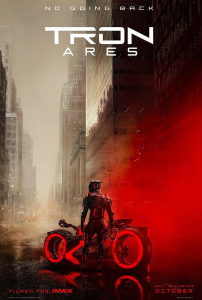

Review: Tron: Ares
Filed under: Reviews
Tron is a film series that was pioneering and inventive, universally hailed as innovating but never quite appreciated enough while playing in the cinema. It fits into that weird sliver of films including Blade Runner and Event Horizon where you get the right genre film fan talking about them, they whisper facts about the films in sacred tones, but you ask the general public and they're, "that movie with the guy with the computers, right?"
Tron: Ares innovates visually, sonically, and asks some interesting questions, but sadly never far enough to make it worthwhile (save the soundtrack). For the sake of highlighting the strengths and weaknesses of the film, I'm going to break my analysis into three segments and then bring it together like a program manifested into the real world from the Grid using lasers.
The most obvious strength of this film, as with the two prior films, is the soundtrack. Atticus Ross and Trent Reznor – under their band Nine Inch Nails – composed and performed the nondiegetic music in the film with the one diegetic piece of music being a deftly-selected Depeche Mode song that served a pretty meaningful plot point within the story (and a song which I would not be shocked if it was a choice of Trent's). The first film's score was the work of the great Wendy Carlos (A Clockwork Orange, The Shining) and was a masterpiece. Wendy, being a pioneer in synthesizer composition, combined her skills with the London Philharmonic Orchestra using variable time signatures and mixing of early synth technology with classical instruments. She eventually ejected the material by the London Philharmonic as she didn't feel they were given adequate time to master the complex compositions and used her trusty GDS to replace them with synthetic instrumentation.
The second film, scored by equally legendary electronic music pioneers Daft Punk (Thomas Bangalter and Guy-Manuel de Homem-Christo), approached like a concept album and one of the duo's last recordings prior to retirement. They treated the album with a degree of love that marked them as clear fans of the original. Unlike Wendy, who in many ways created technology and techniques as she went, Daft Punk, while creating something as innovative as the original film's score, were supported by decades of technological development and the creation of project pipelines that allowed them to compose, arrange, and edit music in a much more flexible and rapid manner. They again used electronic music combined with an 85-piece orchestra conducted by Joseph Trapanese (Oblivion, Scott Pilgrim Takes Off, and almost 200 other works) who arranged the score for the orchestra collaborating with Daft Punk over a period of two years – far more time than Wendy received. It resulted in an amazing Daft Punk album that also serves as an awesome soundtrack and score to Tron: Legacy.
We are now up to the present and Reznor and Ross' composition. Unlike the prior two, it is drawn from entirely synthetic sources. There are no traditional instruments which, thematically, works. The story is from the perspective of Ares stepping out of the Grid and into the real world, so having a synthetic score underlying the story of an artificial intelligence makes sense. Very little of the soundtrack or score contain vocals, and what little vocals there are punctuate the narrative without intruding. Reznor and Ross are old hands at this now and they know how to handle this kind of material. The homages to both prior films are clear with stings and callbacks tied to the prior work, but it's fully unique and of its own creation. It is a perfect soundtrack for this third entry into the series.
Next, we have the visual language. While not the first to use computer animation in a film (interestingly that credit goes to Alfred Hitchcock's Vertigo in 1958), Tron was one of the first to feature an extended use of CGI for the Light Cycle as well as the MCP. The film featured 15 minutes of computer animated footage which, at the time, was unheard of and cost a fortune. On top of that, traditional film techniques were pushed to their limit with the blending of black and white filming, rotoscoping, hand painting of cells, and a host of other techniques and effects that created a distinct visual world that filled my 8-year-old imagination with dreams of entering the Grid (it doesn't help the arcade game was also super awesome). It was a truly stunning and forward-thinking piece of film that used technology as a tool for storytelling and not just a medium to carry the story. Its shimmering lines, neon glow, and the wonders of the Grid inspired future generations to turn to computers to create art and tell stories.
Like the soundtrack, the second film was not faced by the same kinds of limitations as the first. Director Joseph Kosinski was able to lean on innovations to help them pioneer even further into new spaces. Far more realistic than the prior Grid, this time the Encom server looked much closer to real life, showing that as the computers became more complex, so did their simulations. This was carried forward in the film's visuals. Using lighting integrated into the costumes and environments, they were able to punch up the aesthetic, making it feel far more realistic without having to rely on hand painting cells of film. In addition, they used 3D film technology to create a 3D experience from the start. From a pipeline perspective, they also refined technology to perform motion capture and – most controversially – pioneered de-aging techniques that would later be used in films like Rogue One and The Mandalorian to bring long lost (or well-aged) characters back to the screen. All this was done using 18,000 computers to render the art in the film (compared to the prior film, whose entire computing power could probably fit on an Apple watch).
The third film continued to try and push boundaries, this time set less in the Grid and predominantly in the "real" world. We see Ares and his fellow Dillinger programs exiting the Grid to enter our space in a manner that is neat but never quite as impressive as when we step into the computer's world. That said, there is extensive use of 3D camera techniques which are not as popular as they were back in 2010 during the post-Avatar 3D boom. Looking to experience something new, instead of seeing this in 3D (which it was filmed for) or IMAX (which it was ALSO filmed for), I saw the ScreenX version of the film. This is a new type of projection where the side walls are projected at an angle to create a 270-degree panoramic view and frankly, I was let down. From a design perspective, the visuals were strong and the tonal differences between the manifestations of the Grid in the Encom and Dillinger networks was neat. The presentation of computer intrusion over the internet was cool, but nothing was really breathtaking in the way the prior films were. The most awe-inspiring moment was, ironically, the recreation of the Grid from the first film when Ares enters Flynn's old mainframe code (none of this is really how computers "work" but I did enjoy watching some good old-school floppy disks loading, which was a flood of clicking and clacking nostalgia). These scenes in the old server code are packed with moments harkening back to the original film and its low fi and painterly aesthetic, like a Syd Mead painting (Syd helped design the original film's aesthetic). The visuals weren't bad but just lacked the visual punch of the prior films because it was just now in meat space and not as vivid.
That said, I highly recommend against seeing it using the one technological experiment done with this production, ScreenX. Though there's "special footage" shot for the presentation, it's distracting, and I feel you loose elements of the film. The left and right peripheral visuals are lower resolution and deliberately fuzzy to create an experience of being on the "edge" of your vision but it only makes you feel like you are losing action to the sides like using a Super Ultrawide format monitor curved and distorting the visuals. Additionally, there are large seams between the centre and side projections that create the feeling of watching with three 32" televisions a few feet from your face. Immersion is broken and the visuals are compromised. If you do see the film, I recommend IMAX or a traditional format (or even 3D). This will be a much more satisfying experience.
The last element of the film is the story. Oh, boy, what to say here? It wasn't bad, let's start there. I don't think it was terrible but for a film series where the second film was subtitled Legacy, it feels short on that (while ironically leaning on legacy hard at the same time). The first film posited the question, do we truly understand what we have created? The second film touches on that both in the organic world and in the digital world, with Sam Flynn (Garrett Hedlund) – son of Kevin Flynn (Jeff Bridges) – fighting to liberate Quorra (Olivia Wilde), the last ISO (digital life manifested by the ever complexifying networks of computers) being hunted by Jeff Bridge's security program Clu, a monster accidentally created by Flynn. This is a pretty heady idea and it was clearly setting out the pieces for a sequel with Qora and Sam making it into the real world while Kevin held back remaining in the Grid. We had Cillian Murphy as a board member of Encom and the supposed son of Ed Dillinger (David Warner), plus you had the mystery of the ISOs, a manifestation of life created in digital space able to cross between both the digital and real worlds. Again, a compelling story with some interesting philosophical ramifications.
Tron: Ares just feels shallow. Cillian's Edward Dillinger is ejected, replaced with Evan Peters as Julian Dillinger, son of Gillian Anderson's Elisabeth Dillinger and grandson of Ed Dillinger from the first film. Sam has disappeared for cryptic "personal reasons", with Quora disappearing alongside him. We do get a manifestation of Kevin in his old server who acts like a mystic dispensing ancient wisdom and in a way judging the protagonist of the film, Ares (Jared Leto). Ares is working to save Eve Kim (Greta Lee) from Julian Dillinger and one of his programs Athena (Jodie Turner-Smith), while Eve is working to fulfill her sister Tess Kim's (Catherine Haena Kim) legac,y who we only see in a few brief flashbacks. Eve and Tess are new characters along with their sidekicks played by Arturo Castro, Hassan Minhaj, and Sarah Desjardins, who all bring their best to the film but are given so little material it feels like a waste of their talents (with Castro's Seth Flores receiving the most work and being a delightful comedic relief). Eve reads as much as a McGuffin as a character, the source of the "Permenence Code" which would let digital constructs cross over and remain in real space for more than 29 minutes, while Leto and Turner-Smith respectively play an AI that goes rogue and becomes more than what their creator intended and an AI that follows orders mindlessly, and the film explores the philosophical conundrum that creates. In a post-ChatGPT world, this is becoming an increasingly sensitive topic, and I feel the film doesn't really bring enough to the screen to tackle these ideas.
There are a few moments that work. Jodie Turner-Smith's Athena is at once menacing and sympathetic, and Jeff Bridges is in pure Dude mode as Kevin Flynn and is an interesting religious figure for Ares. Evan Peters chews scenery in a way that would make David Warner proud and is evil in a tech bro, FAFO manner that is pretty relevant and interesting, but the two heroes of the film – Eve and Ares – just can't shoulder the weight. Greta Lee is a charming presence on screen, but we don't have enough emotional back story to the character to really connect three films in. We don't understand her connection to the Flynn family beyond being a superfan who rebooted Space Paranoids (the game Kevin Flynn created that made Encom its first millions). Sure, she has a sad back story, but so do lots of people, and it's not really clear where we should connect. Meanwhile, Ares has a Pinocchio complex (that is called out in the film as it is a Disney property), plus there is a peppering of Frankenstein's monster going on too, which is also addressed a bit on the nose in the film. It just hits the beats that you expect, and while Leto has moments of charm, he is a bit flat and just there. This could have been a choice, but I'm not sure it's the right choice.
In the end we're left with some loose ends for a potential fourth in the series, continuing the story and tying into the prior film. Time will tell if this ever happens, but I'm not sure. At the top of the review I said I'd tie this all together. As I said, Tron: Ares isn't bad, it's got potential that just never quite sticks the landing. Elements of it are great (the score), impressive (the visuals), and okay (the story), but it never really clicks. Oddly, the Elija Wood animated vehicle Tron: Uprising and video game Tron 2.0: Killer App do a better job working in this world than Tron: Ares, which is more a testament to their greatness than a condemnation of this film. It feels like there were opportunities here, but for a franchise that has teetered on extinction for decades – resurrected almost 30 years after it was initially released and a second sequel brought back 15 years after the first sequel – it's clear while the creators of the films themselves may be invested in this universe, Disney simply sees it as an opportunity to exploit a hot topic and not a property to nurture. Who knows, we may see if the threads left at the end of the film get resolved. Given their nature, I feel a Disney+ television series – either live action or animated – may be the better path forward, but I'm not confident. I have a feeling in my heart that this world will once again be shelved for another 15 years until some future technological development once again makes it a hot topic that Disney feels it can squeeze a few bucks from (though maybe with the rapid rate AI is going, we may see it in sevenish years this time).
Tags: Tron: Ares, Tron, Tron: Legacy, Jared Leto, Greta Lee, Jeff Bridges, Jodie Turner-Smith, Gillian Anderson, Hassan Minhaj, Arturo Castro
Related Posts
- Review: Dallas Buyers Club
- Blu-ray Review: TRON & TRON: Legacy
- Review: TRON: Legacy
- Academy Awards Coverage: The Hurt Locker takes down the mighty Avatar; our own Douglas Maynard asks the tough questions
- Avatar takes home two trophies in a largely predictable (or at least safe) Golden Globes ceremony








Comments Posted (